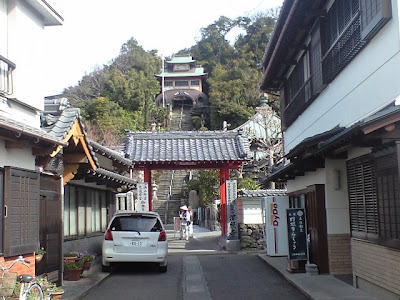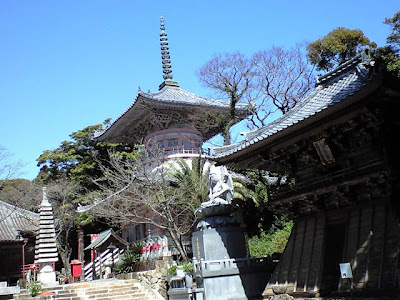I did not sleep well on the night between Days 12 and 13. I had to get up and go to the bathroom about five times with an upset stomach. No idea what the problem was but it sure cut down on my sleep. We did not have to go very far on Day 13 so we went down to breakfast on time and discovered that almost everyone else had already eaten and were leaving as we ate. Most were going to have a long day. Ian and I had a leisurely meal and then the old woman who served our meal offered us coffee. We accepted and stayed quite a bit longer. When we finally left she gave us a package, which she gives to all Pilgrims, containing a banana, a mikan and a yogurt drink. She had taken a liking t0 me so gave me a half of a package of chocolate in addition.
We left and after walking a little ways realized that a young woman from the lodge was running full speed after us. It turned out that Ian had forgotten his hat and she was bringing it to him.
We walked for about an hour and discovered a coffee shop. As usually we could not get past it. The coffee came with pieces of sweet potato, about the size of large french fries, that had been dipped in a sweet batter and fried. They were delicious. More of them arrived with our second order of coffee. We had a beautiful view out over the ocean from our seats. We were told that at the right time of year you could see whales, but all we saw were fishing boats - but they were nice to watch.
The walk was very nice and I would have thoroughly enjoyed it, except for my blisters and an upset stomach.
After stopping in the rest area and watching the cats. We started up the side of the mountain to Temple #24. The trail was supposedly only 750 meters long, but rose 150 meters. It was definitely had hard slog and much longer than the stated three quarters of a kilometer.
When we arrived on the temple grounds, we stopped and ate lunch. Then we did the chanting of the Heart Sutra and then decided to rest some more. In the shop I bought an amulet that is supposed to improve family finances (I think these are very popular at present) and got my fortune told. This comes on a slip of paper that supposedly details your fortune for the coming year. My was
chukichi (medium good luck) overall. This was the same as I had gotten at the local Shinto shrine on New Years - maybe it will be true. Everything is excellent this year, except that I am working too hard, I guess that sounds like a mediumly lucky year.
After left the temple and reached our lodging on the coast below the mountain, we checked in and they asked us about supper. Ian mentioned that I am a (more or less) vegetarian. So they served us a very good, large dish of fried vegetables. Also a bowl of soup with
soba (buckwheat) noodles in it. Plus the usual multiple bowls of rice. The
soba was a change because up to this point we had been in Tokushima Prefecture and there the soup always had
udon in it. Udon is more like a thick pasta or what I always called noodles and it is made from regular wheat.
We were very relaxed because on Day 14 we only had to walk 7 kilometers in total and there would be a town and two temples to explore, the second of which we would lodge in.


 The main gate was at the top of the flight of stairs, although there were more stairs inside the grounds. The objects inside each space on the sides of the gate are straw sandals that are almost three meters tall. Sandals or warrior gods are quite usual as decorations in the temple gates through out Japan, not just at the Pilgrimage temples.
The main gate was at the top of the flight of stairs, although there were more stairs inside the grounds. The objects inside each space on the sides of the gate are straw sandals that are almost three meters tall. Sandals or warrior gods are quite usual as decorations in the temple gates through out Japan, not just at the Pilgrimage temples. It is hard to see in the picture, but the tree in the middle had been cut so that one trunk was waist high and the other about head high. It was growing fine and had been carefully trimmed by the gardeners.
It is hard to see in the picture, but the tree in the middle had been cut so that one trunk was waist high and the other about head high. It was growing fine and had been carefully trimmed by the gardeners.

















































